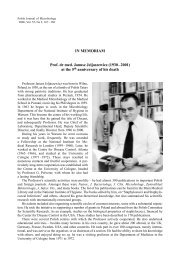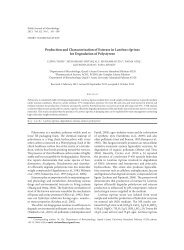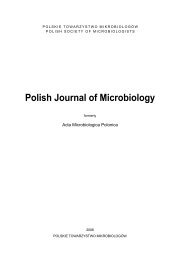No 3 - Polish Journal of Microbiology
No 3 - Polish Journal of Microbiology
No 3 - Polish Journal of Microbiology
You also want an ePaper? Increase the reach of your titles
YUMPU automatically turns print PDFs into web optimized ePapers that Google loves.
188<br />
(von Pawel-Rammingen et al., 2002). Recently discovered<br />
protease SpyCEP is involved in degradation <strong>of</strong><br />
chemokines and chemotactic factors as interleukin-8,<br />
granulocyte chemotactic protein-2, growth related<br />
oncogene α and β and macrophage inflammatory protein<br />
2-α (Edwards et al., 2005; Kurupati et al., 2010;<br />
Sumby et al., 2008; Zinkernagel et al., 2008).<br />
dNases produced by GAS are involved in dissemination<br />
<strong>of</strong> bacteria and escape from neutrophil extracellular<br />
traps (Sumby et al., 2005; Walker et al., 2007). And<br />
finally, large group <strong>of</strong> toxins encoded by GAS genes<br />
(speL, speK, speM, speC, speI, speA, speH, speG, speJ,<br />
smeZ and ssa) is involved in systemic toxicity.<br />
Some <strong>of</strong> the GAS virulence factors, e.g. SpeB, ScpA,<br />
SpyCEP, Mac, SdaB and SpeG, are chromosomally<br />
encoded, however, large fraction <strong>of</strong> virulence factors<br />
such as majority <strong>of</strong> dNAses and superantigens e.g.<br />
SpeA, SpeC , SpeH and SSA are encoded by mobile<br />
genetic elements – phages and conjugative mobile elements<br />
integrated into the chromosome (ICEs – integrative<br />
and cojugative elements) (Beres and Musser,<br />
2007). Based on the comparison <strong>of</strong> genome sequences<br />
<strong>of</strong> multiple GAS strains, metagenome <strong>of</strong> GAS contains<br />
on average about 10% <strong>of</strong> exogenous elements (Beres<br />
and Musser, 2007; Ferretti et al., 2001). So far, 67 mobile<br />
elements (55 prophages and 12 ICE elements) integrated<br />
at 21 distinct loci <strong>of</strong> the core chromosome in<br />
the 12 GAS genomes have been identified (Beres and<br />
Musser, 2007) (Table I).<br />
Over the years, multiple serological, restriction fragment<br />
based and PCR based methods <strong>of</strong> GAS typing<br />
and virulence factors detection were used (Cleary et al.,<br />
1988; Commons et al., 2008; Hartas et al., 1998; Koller<br />
et al., 2010; Lintges et al., 2007; Matsumoto et al., 2003;<br />
Maxted et al., 1973; Moody et al., 1965; Nandi et al.,<br />
2008; Schmitz et al., 2003; Seppala et al., 1994; Swift<br />
et al., 1943). Each <strong>of</strong> the methods presents various<br />
advantages and disadvantages. Serological assays are<br />
usually less precise than molecular methods. Methods<br />
based on the analysis <strong>of</strong> restriction patterns, and methods<br />
based on random amplification, are <strong>of</strong>ten difficult<br />
for analysis and comparison. Multiple PCR assays utilizing<br />
specific targets were developed before the era <strong>of</strong><br />
massive genome sequencing that allows including the<br />
knowledge <strong>of</strong> allelic variations between strains <strong>of</strong> various<br />
serotypes in the design <strong>of</strong> more specific systems.<br />
Also, multiple PCR based systems were designed mostly<br />
as singleplex reactions what increases screening costs in<br />
case <strong>of</strong> detection <strong>of</strong> multiple virulence factors.<br />
Currently, to determine the relationships between<br />
GAS isolates and strains, three major methods are<br />
typically used. The first method, which is regarded as<br />
a golden standard by many laboratories, is pulsed field<br />
gel electrophoresis (PFGE) typing (Bert et al., 1997).<br />
PFGE is <strong>of</strong>ten recommended as a reference method<br />
Borek A.L. et al. 3<br />
in outbreak investigations, especially for food borne<br />
diseases (http://www.cdc.gov/pulsenet/, http://www.<br />
medvetnet.org/cms/). PFGE is a method based on<br />
restriction fragment size polymorphism. Chromosomal<br />
dNA is released from bacteria and digested with<br />
rare cutting restriction enzyme directly in agarose gel<br />
and fragments are separated using alternating voltage<br />
gradient (for a review see (Herschleb et al., 2007;<br />
Slater, 2009)). PFGE typing detects rather large and<br />
recent evolutionary changes in bacterial dNA such as<br />
insertion or excision <strong>of</strong> a phage, large insertions and<br />
deletions and mutations resulting in a loss or appearance<br />
<strong>of</strong> a new restriction site (Tenover et al., 1995). Two<br />
strains are related to each other when the number <strong>of</strong><br />
differences in restriction patterns is below 7 (Tenover<br />
et al., 1995). PFGE is a technique with high discriminatory<br />
power, but it is time consuming and available<br />
protocols require from minimum two days to over one<br />
week to determine PFGE type <strong>of</strong> the strain (Herschleb<br />
et al., 2007). What’s equally important, the technique<br />
requires relatively expensive equipment, skilled labor<br />
and the results <strong>of</strong> PFGE are <strong>of</strong>ten difficult to compare<br />
between laboratories.<br />
The second method used routinely in GAS epidemiology<br />
is emm typing. Emm typing, is a molecular<br />
equivalent <strong>of</strong> serotyping and allows grouping <strong>of</strong> GAS<br />
strains into serotypes/genotypes based on the type <strong>of</strong><br />
the surface M protein (Facklam et al., 1999; Hoe et al.,<br />
1999). It is an easy and straightforward method that<br />
utilizes sequencing <strong>of</strong> a portion <strong>of</strong> the emm gene,<br />
which encodes hypervariable region <strong>of</strong> the M protein.<br />
The major advantage <strong>of</strong> molecular emm typing is rapid<br />
identification <strong>of</strong> novel variants <strong>of</strong> M protein responsible<br />
for new serotypes. The emm typing requires PCR<br />
amplification, purification <strong>of</strong> the amplicon and single<br />
sequencing reaction as a next step (Beall et al., 2000).<br />
The third method, multi-locus sequence typing<br />
(MLST), is based on sequencing <strong>of</strong> seven housekeeping<br />
loci to detect allelic changes. differences in allelic<br />
pr<strong>of</strong>iles in isolates are assigned to known or new<br />
sequence types (STs) (Enright et al., 2001). Similarly<br />
to emm typing the method requires PCR amplification,<br />
purification <strong>of</strong> the product and sequencing. The<br />
method is relatively fast and reliable but in case <strong>of</strong> GAS,<br />
requires 14 sequencing reactions per isolate, which significantly<br />
increases the costs <strong>of</strong> typing. Because <strong>of</strong> the<br />
cost <strong>of</strong> MLST, alternative approaches to detect allelic<br />
changes in genes included in MLST scheme are developed,<br />
such as PCR assays with high resolution melting<br />
curves named Mini-MLST (Richardson et al., 2010).<br />
In this report, we present a rapid and cost effective<br />
method to detect virulence factors encoded by GAS<br />
and phages/ICE elements integrated into genome<br />
using set <strong>of</strong> multiplex PCR reactions. described system<br />
allows easy, simultaneous detection <strong>of</strong> 20 GAS virulence






